Navratan Garh, the main fort of the Nagvanshi dynasty, is located in Gumla, Jharkhand. This historical fort reflects the Nagvanshi culture and history.
Our state Jharkhand, which has a rich history, is a beautiful blend of mystery and tradition. Centuries old untold stories are hidden in the lap of forests spread across a vast area.
Even though Jharkhand has not made much headlines for its ancient heritage and monuments, many precious gems of historical importance are hidden in its lush green landscape.
The most famous name among these is Navratan Garh, located 32 km from Gumla and about 65 km from the capital Ranchi, which is located in Sis block of Gumla district.
This ancient heritage full of mysteries and legends holds an important place in the pages of the past. There are a total of 24 districts in our state and each district has its own specialty, some are known for their natural beauty. Some are famous all over the world for the name of the institution established there.
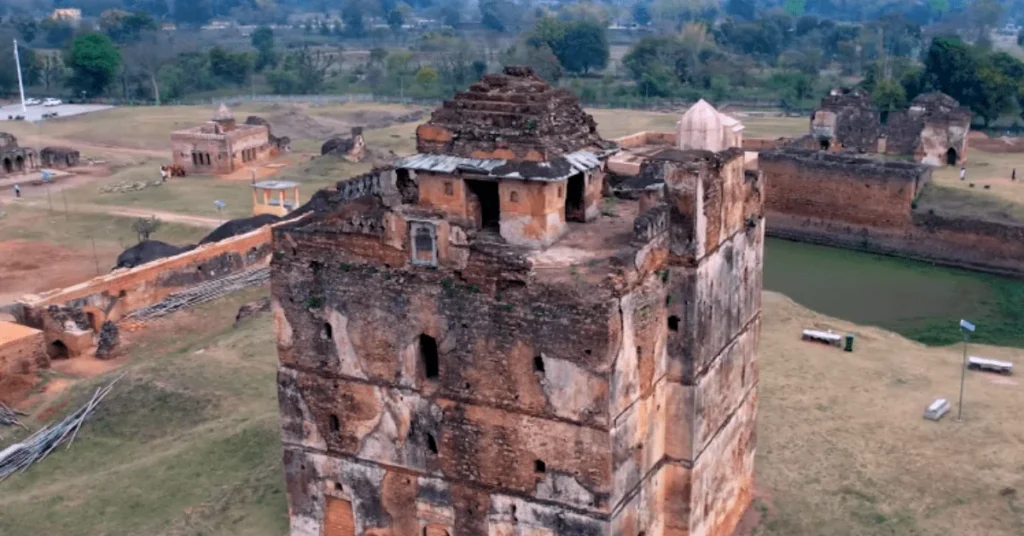
History of Nagavanshis
The heritage of the place where we have come today, the history of the centuries-old empire established there makes it famous. Today we will give you information about Navratan Garh, this empire established by the Naga dynasty about 400 years ago is famous not only in Jharkhand but all over the country today.
And in the last few years, SI has worked well here. He has played a very big role. This time we will try to give you all the information through this article in making Navratan Garh an important tourist destination.
It is said that during the sixth and seventh centuries, three powerful dynasties competed for supremacy in the rich tapestry of central and northeastern India, these included the Pal dynasty of Bengal, the Naga dynasty spread to Jharkhand and Orissa and the Bhoj dynasty of Madhya Pradesh.
Amidst this tripartite conflict, the Nagavanshis faced constant difficulties to keep their kingdom safe. Due to the challenges of security and religious protection, their capital kept changing again and again. Among his permanent works, Navratangarh Fort stands as a proof of simplicity and creativity even after centuries.
This fort is a five-storey fort and it has three floors. There is one more floor above. Four floors and one floor is located below it which you can find during excavation. It is especially artificial. It has a structure of nine rooms in each floor, so perhaps for this reason it is famous as Navratan Garh or Nav Ratangarh Fort.
Regarding the construction of Navratan Garh, some historians believe that the king of the Naga dynasty, Maharaj Shri Raghunath Shah, built the palace and temple here in the early 18th century.
This has been mentioned in an inscription found here. There are also some scholars who believe that the 45th king Durjan Sal built his capital and buildings here.
It is said that he was defeated by the Mughals and was imprisoned in the fort of Gwalior. Raja Durjan Sal was adept at identifying real diamonds. And by pleasing the king, he ensured his release and that of other princes like him.
After returning from the clutches of the Mughals, Raja Durjan Sal built this building in the mid-16th century. Researchers and the Archaeological Department believe that the king lived here only for a few years and on the advice of a Brahmin, he left this place and shifted his capital to Palkot.
This is the site of Navratna Garh. It was built by the Nagavanshi kings. There were many such things here which had taken the shape of a mandir.
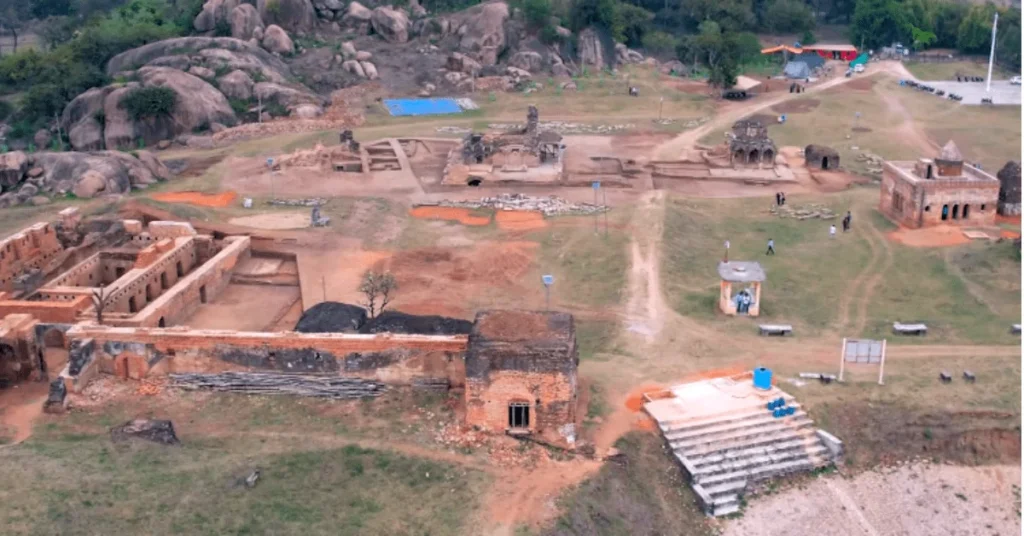
Origin of Nagavanshis
We came to know how Nagavanshis used to live in their olden days, this used to be their guest house here and the king’s fort is on that side. Main fort I like to visit historical places a lot. My parents had told me about this place, so my parents and I have come here together.
Very good work is going on here. The building through SI is very good. I had not seen such a building before. So according to that I liked seeing this building, according to today’s monuments, this building.
Till a few years ago it was buried under the rubble. But only last year it was found during excavation by ASI. And how did the Nagavanshis use it.
There is no exact information about this. But it is said that it was used as an administrative block at that time. And whoever was a messenger who brought a message for the king or who had some work to do here.
So they were kept at this place which is a structure. Some of the broken structures in it have been repaired by ASI. And there are some documents which show that some of these rooms were probably used as jails.
But as we said, there is no such exact information. If we go through the documents or talk to ASI, they say that it was probably an administrative block at that time.
Three inscriptions have been found here. Two of these are present in the temple of Lord Jagannath. The first inscription states that the temple is dedicated to Lord Jagannath. It was built by the royal preacher Harinath in Samvat 1739.
The second inscription shows that King Raghunath built the Krishna temple in Samvat 1739. While the third inscription tells that Harinath Dev, along with his brother Gokulnath, built a temple in Samvat 1767.
Currently, Navratan Garh, protected by ASI, contains 10 monumental remains. These include Jagannath Temple, Rani Lukai Kamal Shahi Mahal, Yogi Mat Talab, Royal Palace, Loh Thop Mat Yoni Peeth with Rock Cut Shivling, Monolithic Rock Cut Sculptures of Ganesha and Jagannath Temple, two.
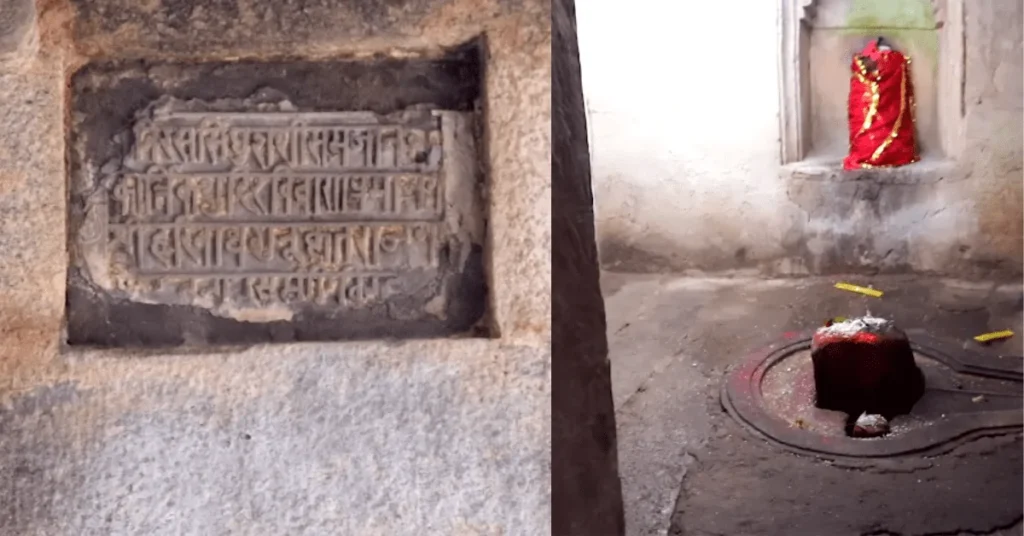
For example, when we talk about Nav Smarak, it is a central protected monument. This Navtan Garh fort or its complex, which came to the Indian State in 2019, is symmetrical in a total area of 12 acres.
It has a group of many monuments. There is Jagannath Temple in it. Its main fort is along with it there is your Lahu Tapa Math. Rani Lokai Math. Many such monuments are included in it. And this Navtan Garh. It was earlier also known as Dosa Garh.
It was established by Durjan Sal, who was a king or a Nagavanshi king. After that, it was ruled by many kings after him and in the same order, its premises have been developed at many moments. Raja Durjan Shal was the one who was imprisoned in Gwalior during Jahangir’s period.
He built this fort of Navratan Garh, he was imprisoned. According to that book, he was released in 1615 and after 12 years or in 1627, after that, all the kings and Maharajas who were imprisoned with him. When all of them came to Khukhara Garh because the capital of that time used to be Khukhara Garh.
After that time, Durjan Shal shifted his capital from Khukhara Garh to Navratan Garh and it is also known that all the people who were there, all the kings and Maharajas who were captives. Those people, because there were probably nine people in number.
It was built with the help of those people. Maybe that is why it is also called Navratan Garh. Secondly, we know it by its name. Dasa Garh is behind Nav Ratangarh, what we heard is that there were nine associates of his who were with him. This is called Navratna. The famous Kapil Nath temple is situated near Nav Ratangarh.
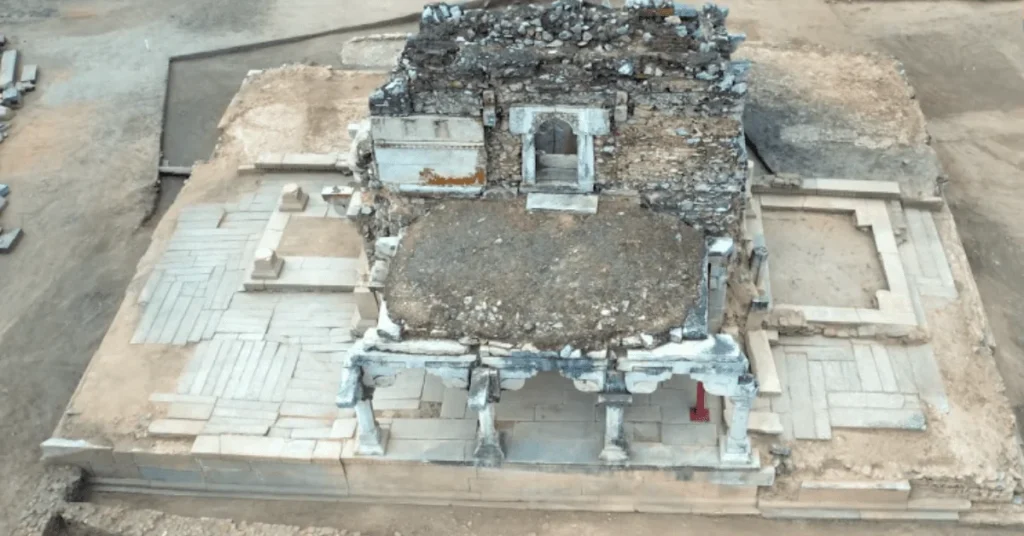
Archaeological excavation said:
We tried to do some excavations in the mandir and do an archaeological excavation to see what is inside it. So in 202021, we took up this excavation and when you see the old photographs here, there is a tall mandir. And nothing was visible inside that mandir.
Then we did an archaeological excavation on it, so basically we found three different cells in it, one cell on the eastern side was a big hall. Which is about 40 meters by 20 meters. In the middle chamber, three big rooms were found and after that, there is a chamber on the western side.
That too is a hall. So this is how the excavation was going on. Here archaeological excavation was going on. Excavation was going on. So at that time we tried to preserve the things that were coming out in a very good way, so we removed all the plaster that was here.
All the doors that were below were excavated very carefully and were removed properly, you can still see them. All the plasters here are from that era. At some places, when there was a great need, we tried to conserve them a little. The rest, we have preserved it in the same way in which it was removed.
In the future, we will try to take this conservation work of ours further and if you look at it carefully, you will see two or three different phases in it. One phase is what you originally had and after that there is another phase above it which was built by the later people to build and live in it.
But in the original phase, the old phase, you will see that very good carving and workmanship has been done in it. The doors here are of different styles. The five doors that were found in the main hall also have a different design. And all the shelves that are below.
The style of their construction is also completely different. Hopefully, it must have been used for some administrative work in those days. This place is very nice to see.
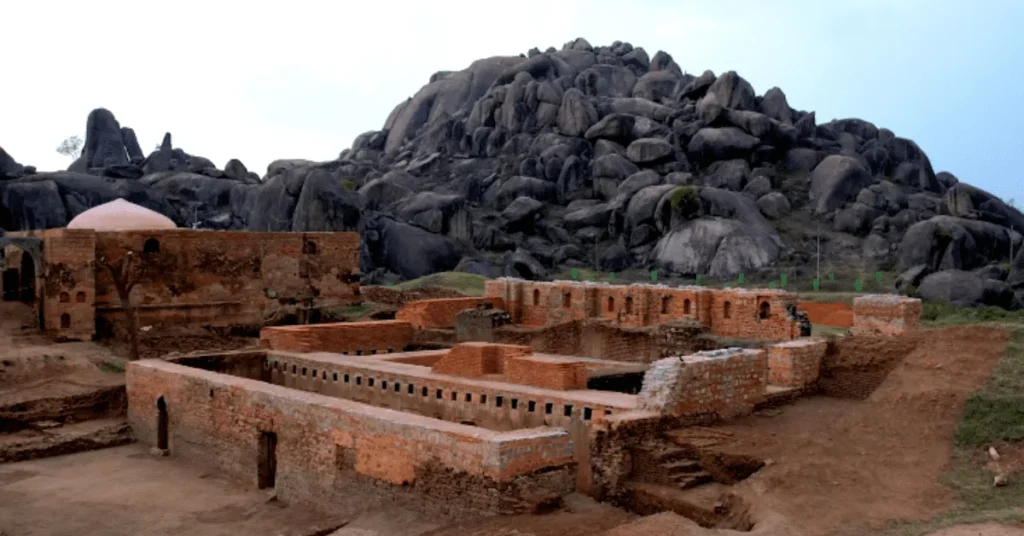
Amazing confluence of faith and art
Which is considered to be a part of this fort. Here, an amazing confluence of faith and art can be seen. This temple is a unique example of architecture and construction art. The priest of the temple tells that the temple was built by Nagvanshi King Ram Sai in the year 1700.
Lord Bholenath has been worshipped here for centuries. At first, Khura was the place of residence of the kings, from there a wind used to come. And it used to come and stand where Baba Bholenath is inside the Garbha Griha. At that time there was no temple and she used to feed milk there.
He used to come out in the form of a child. He used to drink milk from the milk. Then the shepherd informs the king. The shepherd said that the king has been seeing that the wind has been coming for many days.
But I did not know that today we followed Bachi and saw someone feeding milk to a snake. He said, you are speaking the truth, you are speaking the truth. If you are lying then you will have to suffer the punishment of the fort, I agree.
He said, let us see from others. Raja Saheb got a direct darshan of Baba Bholenath in the form of a child, this incident is of the year 1700. It is inscribed in it and also written.
Samvat Satar Sa Ravi Jaan Aad Sudhi Tritiya Shani Maan Shri Ram Shah Nardev Viraj Brahmachari Shiv Komat Saaj, here again the thing written is the same.
Muni Ras Sindhu Sash Sam Jaan Kartik Sudhi Ra Vivaan Praman Shri Harinath Guru Krit Raj Navratan Garh’s expansion is spread much beyond the present four walls.
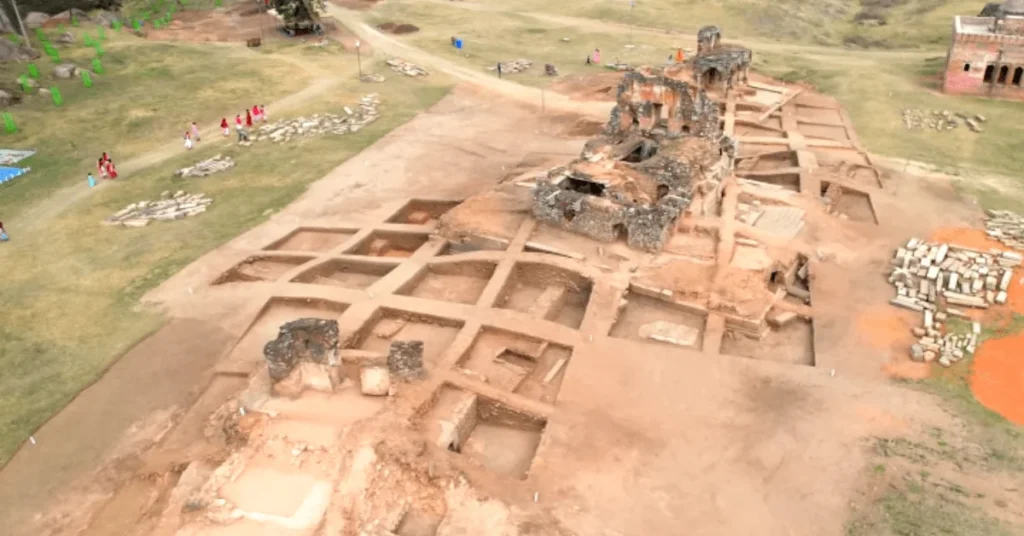
These structures adorned with architecture
There are many areas outside the complex where remnants of the past still exist. Some are ancient and charming. While others have faded due to the ravages of time. Among these unique treasures, Dhobi Math reflects the artistic splendor of bygone eras very well.
These structures adorned with intricate architecture create a sense of awe and wonder. Which is a proof of those skilled hands. Who prepared them centuries ago. Terracotta has a very special place in the historical heritage of Jharkhand.
Nearest Tourist Place in Gumla District
- Nagpheni River, Jagganath Temple and Waterfall in Gumla.
- The Tanginath Dham Temple located in Gumla | Jharkhand
- Basudev Kona Temple located in Gumla district of Jharkhand
- Maha Sadashiv Temple in Gumla District of Jharkhand State
About the structures
It is known as Dhobi Math. At present, there is a 14-acre part of Navratan Garh. Which comes under the protection of ASI. But apart from that, there are many such structures which exist outside it as well. Dhobi Math is one of them.
Here, work has been done on terracotta very meticulously. Some of the structures present in terracotta are from the Mahabharata period and some are also from the Ramayana period because it does not come under ASI.
Due to this, its conservation is not being done properly. If the government pays attention to this, then this heritage of ours can be preserved properly. A Bavli is present near Dhobi Math. Which is a proof of both simplicity and practicality of the residents of the state.
This structure, which was once an important lifeline for the royal family, is still in active use today. Its strong walls bear witness to the ups and downs of generations. Even today, while fulfilling its original purpose, this Bavli is an important source of water for the surrounding villagers.
Every monument present here is a unique chapter in the rich history of this empire. The Bavli was built during the reign of the Nagavanshi dynasty about 300 years ago. Some historians say that the queens used to use it for bathing.
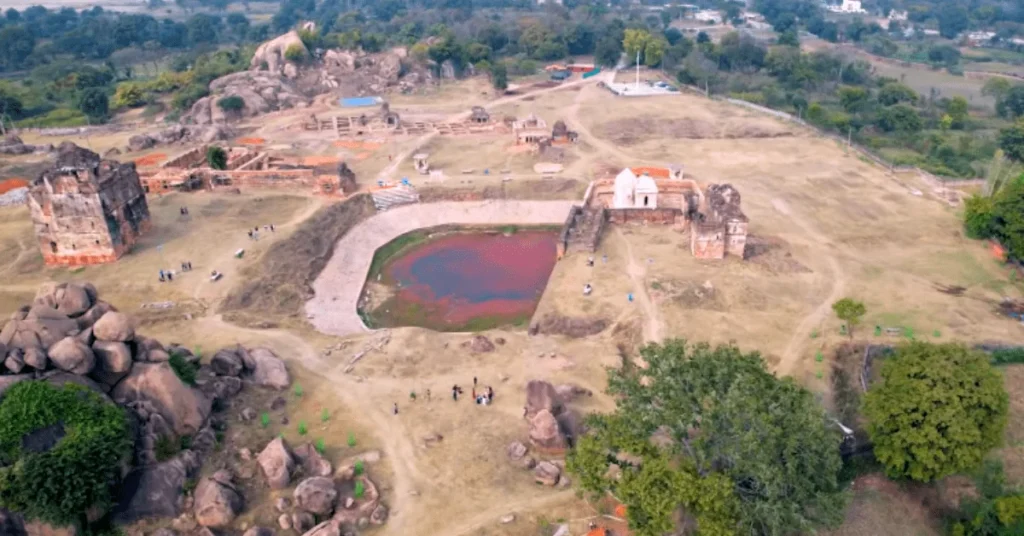
ASI (Archaeological Survey of India) conservation teams say:
Even after so many years of construction, its condition is very good. And even today the local people are using it for water supply. People can come here comfortably and fill water. The structure of this Bavli is very beautiful. And inside there are some places where you can keep your things.
Navratan Garh is a major evidence of the golden history of the Nagavanshi kings, which not only contains the heritage of our state but of the whole country.
Its majestic structure built with Surkhi limestone and Lahori bricks is an echo of the architectural splendor of the Mughal period. This heritage is a living proof of the artistic skill of its builders.
It is our important task to preserve it. In preserving it, the Indian Survey uses all the same techniques. In the condition in which we have received it. To preserve it, we mix Bel, Jaggery, Moong Dal, Urad Dal and leave it for a few days.
It remains in the same condition for 15 days or at least and when it mixes together and a thick solution is prepared. Which is capable of joining anything, then after that we preserve it in the same way or pattern on which the old monument is.
Following the same standards, we preserve the structure. And for color we use catechu in it. Apart from this, it requires water for a long time to give it strength. A notable heritage exists at a short distance from Navratan Gadh. Its architecture is very similar to the Jagannath temple of Navratan Gadh.
Local people believe
Many people believe that this place is Mausi Bari. Even the local people know it by this name. Whatever kings of the Naga dynasty were there, they are spread in various areas i.e. in Ird Gid village. They also come in Nagar village.
But this is its Mausi Bari. And there is our Jagannath temple and we know about Jagannath temple and Mausi Bari that the chariots of Jagannath come on the day of Balabha Rath Yatra. Then after that they come to Mausi’s house.
So this is Mausi’s house, Jagannath ji’s aunt’s house. So they come here and stay here for nine days. So this is its spiritual aspect. The villagers know it by the name of Mausi Bari. Historians have also described it that this is Mausi Bari.
But its structure is still the same. The upper part has turned saffron. But even a look tells that there must have been one floor. But there was another floor above. Efforts are on to revive Navratan Garh by the Archaeological Survey of India.
They are ensuring that every damaged aspect is brought back to its former form by using the same materials and techniques used centuries ago.
Excavation by the Archaeological Survey of India
We are currently carrying out an excavation till 2024. In the excavation, we are gradually exposing its remains. So that we can get information about the remains of that time and conserve it.
ASI is carefully preserving the precious remains obtained through excavation programs. From ancient coins to delicate terracotta toys, each discovery offers a glimpse of the rich cultural heritage of Navratan Garh. The archaeological excavation that took place here
received very encouraging results, as a result, we took its license for the second session and what we have now in the license of the second session.
A lot of antiquities have been obtained. Which tells how the people of that time lived. This tells about their daily routine. Apart from this, you have Jagannath Temple One Two and besides that there is another temple behind it.
This has just been cleared in this excavation in this excavation. Whatever structure it has. It has come out in full form. And there is still a lot of possibility here. It is in itself a puzzle.
Work by the Archaeological Survey of India
The Archaeological Survey of India wants to solve this puzzle and give such a heritage to the villagers and Jharkhand. Which can be proud of that Navratangarh stands as an important pillar of the heritage of our state.
Which is providing invaluable knowledge related to history and culture through its remains. This remains of the ancient empire is such a mirror of the past. Which gives us a glimpse of the life and heritage of our ancestors.
At present, the Archaeological Survey of India is continuously working towards the conservation and revival of the heritage of Navratan Garh. Due to their efforts, Navratan Garh is telling the stories of ancient times to the tourists.
Excavation work is being done continuously in Navratan Garh. Every day a new carving appears as a puzzle in front of us. Sometimes there are some remains which solve centuries old mysteries. But the good news is that through this effort we are getting a chance to understand our history.
We are getting a chance to know the story of those empires which used to be centuries old. But whenever we come here to see and understand this heritage, it is important to keep in mind that its preservation is not only the responsibility of the government but it is also our responsibility.
Relevant FAQs about Navratan Garh
1. Where is Nav Ratan Garh located?
Nav Ratan Garh is located in Gumla, Jharkhand.
2. What is the historical significance of Nav Ratan Garh?
Nav Ratan Garh was the main fort of the Nagvanshi dynasty, the ancient rulers of the region.
3. Who built Nav Ratan Garh?
Nav Ratan Garh was built by the Nagvanshi dynasty.
4. What type of structure is Nav Ratan Garh?
Nav Ratan Garh is a fort that reflects the power and culture of the Nagvanshi dynasty.
5. What is the best time to visit Nav Ratan Garh?
The best time to visit Nav Ratan Garh is during the winter season, when the weather is pleasant.
6. How is Nav Ratan Garh being preserved?
The conservation and restoration work is being carried out by the Archaeological Survey of India.
